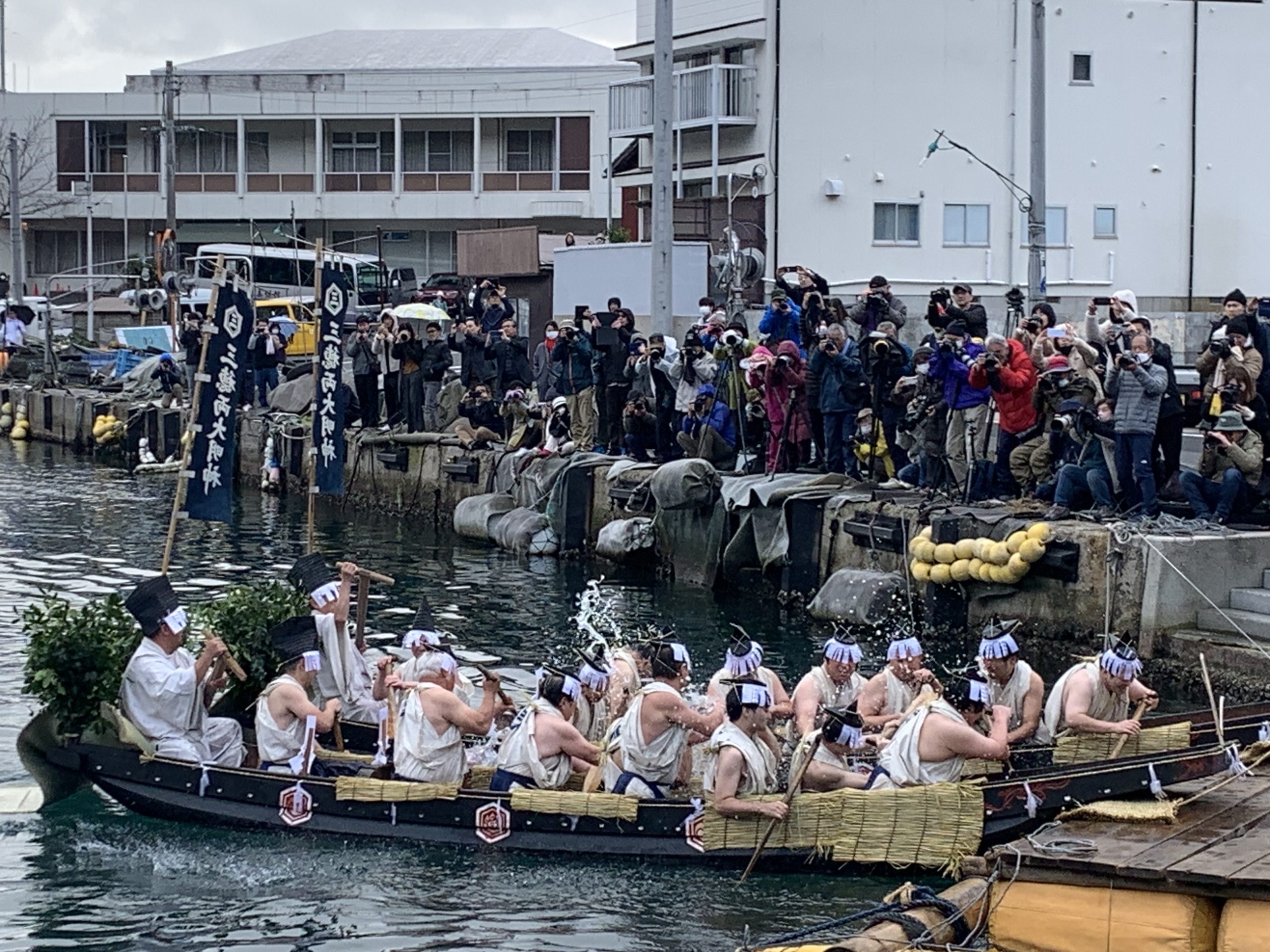Mihonoseki – The solemn atmosphere covered Mihonoseki Fishing Hamlet (now a major tourist site in Shimane) on December 3rd because of its venerable traditional Shinto ceremony called the Morotabune Shinji, which attracted many sightseers despite the chilly temperature.
Mihonoseki is situated at the eastern end of the Shimane Peninsula, approximately three hours away from Tokyo (Haneda Airport) by public transport. The journey involves a 1.5-hour flight from Haneda Airport to Yonago Airport ALL NIPPON AIR (ANA), followed by a 20-minute ride on the JR Sakaiminato line or bus to Sakaiminato Station. From Sakaiminato Station, visitors can transfer to the Mihonoseki Community Bus, heading towards Ui Ferry Landing Stage, for a 10-minute journey. Finally, a 10-minute bus ride from Ui Ferry Landing Stage will bring visitors to Mihonoseki. Total roundtrip costs are around 70,000 yen (except for hotel charges).
The Morotabune Shinji reenacts a scene from the Kojiki, Records of Ancient Matters, and it is said that one day, Okuninushi, who dwelled in Izumo, was requested to cede his land to Amaterasu (is enshrined in Ise), the Sun Goddess. Okuninushi entrusted his child Ebisu to decide whether they should give their ruled land to the Sun Goddess. Thus, Okuninushi dispatched his representatives to Miho Shrine, where Ebisu lived, by sea. The Shinto drama tells the story.
The Shinto rite started at 1:30 p.m. ‘don, don, don‘ echoed the taiko drum throughout the precincts of Miho Shrine. Shinto priests exited the office and entered the stately, wooden main hall after their parishioners. The Shinto believers, called ujiko, had already waited for the priests by kneeling in the formal seiza position in lines. Like samurai, the locals wore formal kamishimo dresses engraved with each family’s crest. The crests, known as kamon, are used for ceremonial occasions to represent the family—something many Japanese consider a significant factor compared to individuals in Japan.

‘Ohu, Ohu, Ohu‘, one of the priests, wearing green attire, had uttered his esoteric Shinto prayer. Subsequently, two young women in white blouses and vermilion pleated trousers performed their unfathomable Shinto dance to bamboo flute music. This rite was crucial to plea the Kami of Miho Shrine, Ebisu, to descend. Ebisu is deemed to be a god of maritime safety and good business.
The middle-rank priests gave a few grains of rice to the ujiko to unite the Kami. The distribution of rice grains in Shinto is akin to breaking bread in Catholicism. Then, the chief priest, wearing orange attire, called his believers’ names to confirm the will to row. “Ou (Yes, sir),” replied the locals, person by person, dashing to a changing room.
Before 3 p.m., two divisions of 18 members—one division comprising nine men — and a guide came down to the bay from the shrine’s ground, wearing white shirts and blue trousers resembling the ancient uniform. The men got on two boats. Two division officers called touya with wooden-made sacred Macca Swords ordered mooring men to let go of lopes. The other members include one staff officer, one helmsman and six rowers per boat.

Morotabune translates to ‘boat with many hands,’ conveying the concept of a boat swiftly sailing. The oarsmen shouted, ‘ya-ya’, and the boats competitively headed to the Maroudo Sha Shinto Shrine, dedicated to Okuninushi; upon arrival in front of the shrine, the touya showed their guards of honours by presenting the wooden swords to the master deity of the Izumo province. Only then did the boats briskly alter their course to the starting point, and rowers exuberantly began to splash cold water on each other at the front of the pier. Upon coming alongside the land, the touya dashed competitively to the shrine’s gate to dedicate the sacred swords.
Upon Touyas getting on the boats again, the entire crew saluted the chief priest representing Ebisu, the main deity of Miho Shrine. The chief priest returned the salute, chanting the Shinto Mantra, ‘taka-sando,’ and praying the Shinto sutra, which meant Ebisu accepted the request by Amaterasu, bringing peace to the land of Izumo. Without Ebisu’s wise decision, fierce hostilities between the ancient Izumo and Ise might have occurred. The men and sightseers remembered engraved in their minds what Ebisu did and learned the importance of the Miho Shrine as to Japan’s creation.
After finishing the highlight, the boats resailed and circled in the bay, splashing cold water on each other and completing the Shinto rite.
Morotabune Shinji meets every December 3rd.
(Words by Takashi Saito)
How to get to Mihonoseki
608 Mihonoseki, Mihonoseki-cho, Matsue-shi, Shimane-Prefecture
By rental car(Recommend)
It takes 40 minutes from the JR Matsue Station to Mihonoseki through Rute 431 and prefectural road 2.
By Bus
then board the Ichibata Bus bound for Mihonoseki Bus Terminal (45 minutes). Transfer to the Mihonoseki Community Bus Mihonoseki Line and get off at “Mihonoseki”bus stop (30 minutes).
Remark: You are required to understand Japanese if you choose this way.


One Reply to “Mihonoseki celebrates Morotabune Shinji”